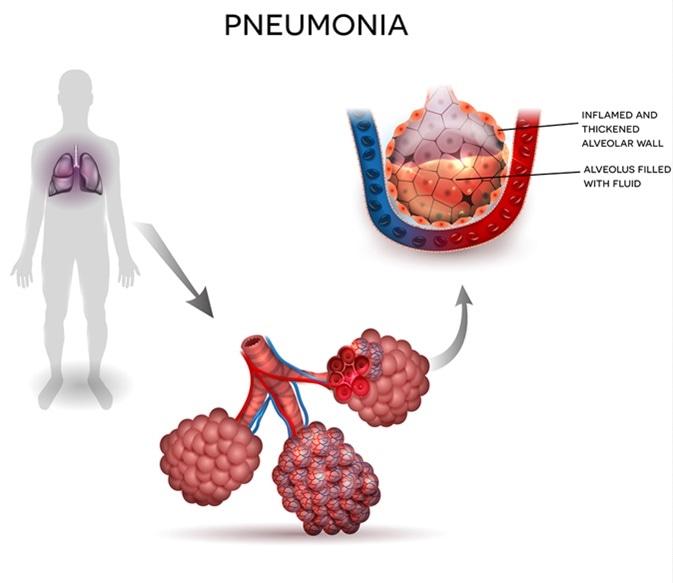For The Latest Medical News, Health News, Research News, COVID-19 News, Pharma News, Glaucoma News, Diabetes News, Herb News, Phytochemical News, Thailand Cannabis News, Cancer News, Doctor News, Thailand Hospital News, Oral Cancer News, Thailand Doctors
Pneumonia is an infection of the respiratory system which affects the lungs of the patient. The air sacs in the lungs, called alveoli, get filled up with fluid or pus. This causes a person difficulty in breathing accompanied by body chills, a fever, and cough with phlegm. It can be caused by either viral or bacterial infection. Diagnostic tests will be required to pinpoint the exact cause of the infection.
The illness can severely affect the health of children less than five years old and adults more than sixty five years old. Those who suffer from conditions like diabetes and heart disease, or have a weakened immune system due to prolonged illness or are undergoing chemotherapy, are also susceptible to pneumonia. It can be a potentially fatal illness for those with low immunity, especially if it not diagnosed and treated in time.

While Walking Pneumonia may sound like a serious illness, it is in fact a milder version of actual pneumonia. In as much as the patient may not even realize that he is suffering from a serious respiratory illness and continues to walk around following his daily routine. There may be symptoms such as low energy levels, mild fever, a cold and cough, but the person does not feel the need for bed rest.
It can develop into a more serious form, and for this reason any lingering symptoms should be brought to the attention of a medical health care practitioner. The infection usually come from the community and will subside faster if treated with appropriate medication. In some cases additional symptoms like skin rashes or renal dysfunction may also show up.
Walking Pneumonia is caused by the bacteria Mycoplasma Pneumoniae. It is usually responsive to antibiotics, however sometimes it may be resistant to particular antibiotics. It begins with a mild set of symptoms which become progressively worse over the next few weeks. Only 1 out of 3 people who have Walking Pneumonia will develop actual Pneumonia. This means that most people who are lucky enough to have milder symptoms may never realize that they had Walking Pneumonia and may heal without any medication.
Pneumonia is often community acquired and caused by the bacteria belonging in the Streptococcus or Staphylococcus genus; these are commonly known as Strep and Staph infections, as appropriate. It is also possible to acquire pneumonia from a viral infection. Since the symptoms of pneumonia are more severe the patient will feel tired and want to rest the body. The fever spikes, body chills and cough will be enough of a reason to get medical attention. Once on proper medication the prognosis is bright for recovery, as long as no additional complications crop up.
The two main tests to diagnose all kinds of pneumonia are blood tests and chest x-rays. There are primarily three types of blood tests: culture, serology and molecular.
Since both forms of the illness are contagious it stands to reason that those who are constantly around other people or generally spend a lot of time in crowded areas are more likely to be at risk at catching the infection. The most common place children catch the infection is at school where they may be exposed to someone contagious.
For adults places such as college dormitories, nursing homes, hospitals and even military barracks can be places rife with infection. Although the general adult population with a healthy immune system is less susceptible to pneumonia, constant exposure to the infection over a long period of time can result in contracting the illness.
There is no effective way to avoid succumbing to pneumonia. General precautions such as avoiding germs and washing hands regularly with warm water and soap do help to keep the illness at bay.